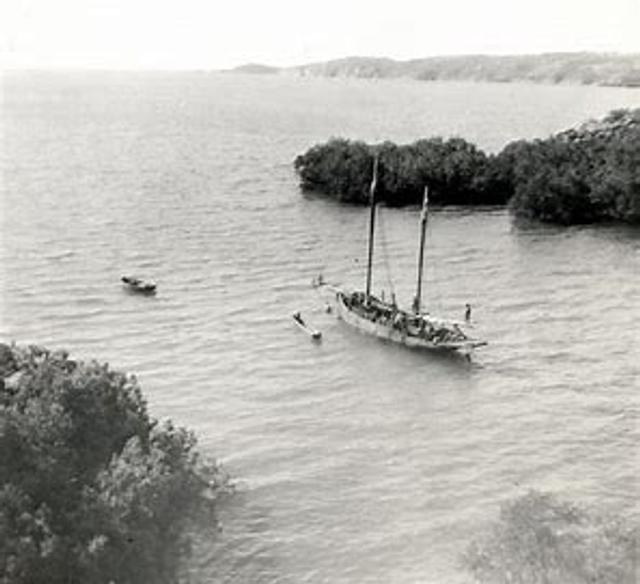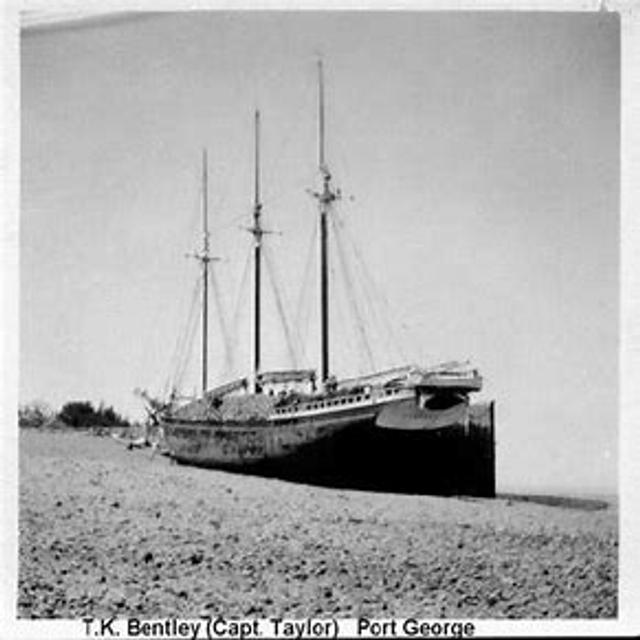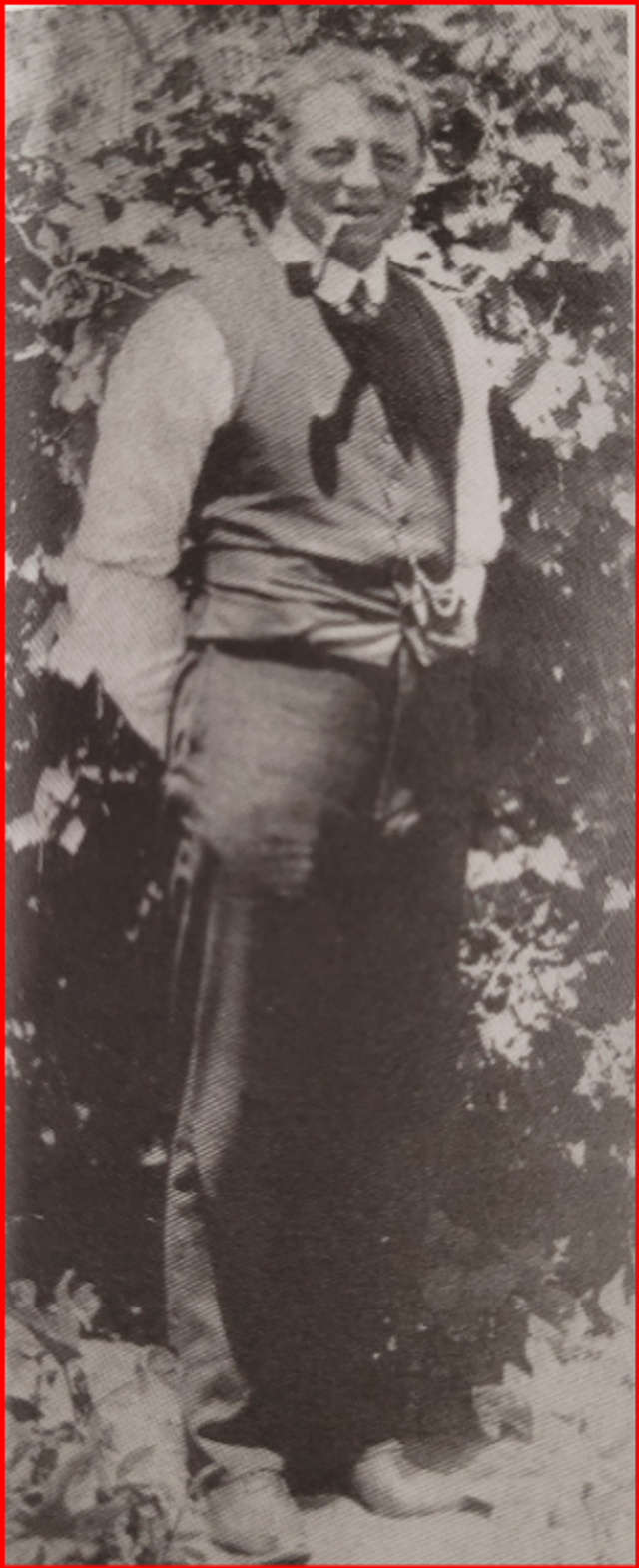Frank Bass and John Smith
Vessel Name: Henry
Frank Hugo Bissenberger (Bass)
John Smith
Lost between Cape Jaubert and Wyndham; found to be murdered
2 December 1920

Sunday Island lugger

Port George lugger

Frank Bass 1920 (West Australian State Archives)
Captain John Morgan bought the Henry in 1914. She had previously worked as a pearling lugger for her owner and master Tom Ure (Thomas Alexander Ure). Henry had two sister boats: Neta and Alinora. Tom had two partners Jack Clarke and Walter Colt. John bought Henry as a deceased estate. [See the Tom Ure and Jack Clarke story].
John put Henry to work fishing for beche-de-mer, turtle shell and trochus shell, and was the first master to survey the northwest for mineral deposits. He sold the Henry after a few years.
On 4 September 1920, Eerie McGuire and another German were murdered on Mary Island, and on 26 September an officer from HMAS Geranium was killed when he strayed from a shore party on the Anjo Peninsula. The main suspects were Aboriginal men. Henry was despatched from Wyndham to the Drysdale River Mission carrying police documents and mail relating to the murders.
John and his crew stayed for six days at the mission. Some Aboriginal people came to the mission and brought the dead warrant officer’s head, and some body parts. Police buried the remains. The case was solved, and Henry and her crew were discharged from duty.
On their way back to Broome on 28 November 1920, between Admiralty Gulf and Voltaire Passage, Henry impaled on a submerged rock which tore through the hull and held her fast.
The crew were forced to abandon Henry. They began to row to shore in Henry’s 12 ft [4m] dinghy, taking food and provisions for a month. On 28 October they made a camp 150 miles [240kms] from the Catholic Drysdale River Mission and 320 kms [200 miles] from the Presbyterian Mission at Port George.
In 1920 the crew of Henry consisted of;
Captain “John” Johnston, owner and master,
Frank Bass (Hugo Francis Bissenberger), engineer and fitter, 42-year-old South Australian, more recently from Geraldton, WA, married with children.
Captain “Harry” Scott, pilot
Launcelot “Dick” Pascoe, 30-year-old Cornish sailmaker
Gordon Stanley, former store manager, 40 years of age
John Robert Smith, 45-year-old New Zealand boiler maker, ex-lumper, from Fremantle, married with children
Frank had been a teacher. Due to his German ethnicity, he was asked to step down when the Great War began. He went fishing to earn a living, and consequently he came to be aboard Henry with Captain John and his crew.
The crew set off for the Drysdale Mission, but the mission’s vessel Voladora was on its way to Broome. Harry and Dick decided to take the dinghy to Port George Mission to ask for the use of their lugger, the WS Rolland. The next closest place with a boat was Camden. Harry and Dick took some supplies and began rowing the 200 miles [320 kms] to Camden Sound to ask for use of their lugger. They reached Camden Station on 7 November, only to learn that the WS Rolland had sunk a week before. Harry and Dick rested for two days before retracing their way south. They left the Mission on 9 November.
This time the weather and tide made the journey difficult. Camden had been unable to provide any supplies and Harry and Dick were rationing their food and fresh water. The crew set off for the Drysdale Mission, but the mission’s vessel Voladora was on its way to Broome. Harry and Dick decided to take the dinghy to Port George Mission to ask for the use of their lugger, the WS Rolland. The next closest place with a boat was Camden. Harry and Dick took some supplies and began rowing the 200 miles [320 kms] to Camden Sound to ask for the use of their lugger. They reached Camden Station on 7 November, only to learn that the WS Rolland had sunk a week before. Sometimes Dick towed the dinghy through the shallows. Harry had a badly infected foot.
The men reached the Sunday Island Mission on 19 November. The Sunday Island lugger was badly damaged and had gone to Broome for repairs. Missionary Sydney Hadley treated Harry’s foot, but the mission had no supplies to spare.
Running out of options, Harry and Dick left Sunday Island on 20 November, heading for O’Grady's cattle station at Karratha Bay. Mr O’Grady had taken his boat to Broome.
Refusing to give up, the men started rowing for Swan Bay where the Hunters had their homestead. Again, the owners were absent. Harry and Dick walked along the beach to the Cape Leveque Lighthouse. At last, they were able to get provisions and the lightkeepers sent a telegram to Broome Police on 24 November.
Replenished and rested, Harry and Dick had run out of options. They were in poor health and exhausted. They decided to back track to the crew’s original camp and returned to the Hunters station where they had seen a damaged 22 ft [7m] sailing cutter. They made repairs and set off on 25 November. Sailing was easier than rowing, and much less tiring.
The cutter reached the Port George Mission on 28 November, and missionary Paull was there. Further repairs were made to the cutter, and the mission afforded the men fresh bread.
Harry and Dick reached the original Cape Voltaire camp on 2 December, to find only Captain John and Gordon Stanley were there. Local Aboriginal people traded meat for flour, which helped feed the crew. In return John and Gordon provided medical care to some of the Aboriginals who had contracted syphilitic ulcers.
Meanwhile John Smith and Frank Bass thought Harry and Dick must have come to grief along the way to find help. It had been a long time since they first left the camp. Frank and John made a canoe and a canvas coracle with a wooden frame, intending to paddle south. Captain John and Gordon tried to talk the other two men into remaining in the camp, but Frank and John insisted they go to find help.
They took half of the remaining rations. Both boats capsized on the second day when they met with heavy rain. The men waded ashore and began to walk the 200 miles [320 km] to the Drysdale Mission. They were seen by Aboriginal people who reported what they saw to Captain John. Frank and John had started to walk cross country.
Meanwhile, Harry and Dick remained with John and Gordon in their camp until 4 December, 37 days since the wreck. With provisions running out and their health deteriorating, the men set off in the borrowed cutter reaching Broome on 17 December. They believed Frank and John Smith had perished.
Once the crew had reached Broome, a minimum of 338.68 miles (545.05 km), a search was started for Frank and John Smith. State shipping service vessels Kiwini and Voladora and a private lugger were despatched to search the coast. On 8 December the Kwinana left Wyndham and anchored off Cape Voltaire and sent out search parties.
Searchers found the abandoned coracle and canoe. At the camp there was a biscuit tin that contained a note left for the missing men. They had not returned and found the note.
Trackers found signs of Frank and John Smith’s passage through the hostile environment. The crew of Henry joined the search parties as they followed the men’s path. They had not reached the Drysdale Mission
Many years later the remains of Frank Bass and John Smith were found between Derby and Wyndham, where the Drysdale and Forrest Rivers run. Evidence at the scene showed they had been killed by Aboriginal people from the area. The men who killed Frank and John were never found and no arrests were ever made.
Captain “Harry” Scott kept a record of his trials after the wreck of the Henry, written on scraps of paper and whatever he could find to write on. It recorded the epic journey of the crew of the Henry, and the loss of Frank Bass and John Smith.
Frank Bass and Jane Jean Crawford had married in 1908, and they had three children: Vivien, Clive James and Laurie. Clive was born in 1916. He was an engineer and became a successful cray fisherman in Port Denison, Clive died in 1975 at the age of 58 and is buried in Fremantle Cemetery.
His family have continued to fish successfully, with Clive's son George expanding into a marine logistics service to the oil and gas industry, and a seafood retail outlet. George was born in 1948. He began crayfishing while he was still in school and had to stand on a fruit box to reach the wheel and the winch. In the early 80s George had the Clive James ll built and named after his Father. She was the largest cray boat in the Port Denison fleet. The original Clive James was renamed Ann Lyn, after George’s wife.
In the next generation, Clay Bass now operates the biggest cray boat on the coast, aptly named Poppa G. The Bass family have fished for four generations, expanding their business with each generation.
